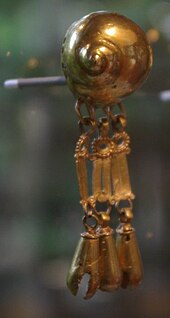Mixtecs
The Mixtecs or Mixteca (derived from the Nahuatl language of Mixtecapan = "people from the cloud country" or Mixtecatl = "cloud people") are a group of Mexican indigenous people who originated in the Mixteca region , now part of the Mexican state of Oaxaca , the neighboring Puebla in the northwest and the state of Guerrero in the northeast .
language
The Mixtecs speak Mixtec and, depending on the dialect, referred to themselves as Ñuu savi , Ñuu djau , Ñuu davi , Naa savi - sometimes also as Tay Ñudzahui or Ñuu dzavui (“people at the place of the rain god”) and formed at the time of the Spanish conquest of Aztec Triple Alliance one of the largest peoples in southern Mexico. Together with the neighboring Zapotecs , they speak a variant of the Otomangue language family. A distinction is made between the actual Mixteco with several languages and dialects (approx. 450,000 speakers) and the closely related Cuicateco ("Cuicatekisch", 12,000 speakers) and Trique ("Triqui", 24,000 speakers).

history
The Mixtecs were the bearers of a highly developed pre-Hispanic culture in southern Mexico. According to written sources, the beginnings of their culture can be traced back to the 7th century. Important former cultural and power political centers of the Mixteca were the capital Tilantongo ( Ñuu Tnoo-Huahi Andehui - "Black Temple of Heaven") as well as the cities Achiutla, Cuilapan, Huajuapan, Tlaxiaco, Tututepec, Juxtlahuaca, and Yucuñudahui. They later rose up against the Spanish occupation and were subdued by the Spanish with the support of indigenous auxiliaries from central Mexico under the leadership of Pedro de Alvarado . During the colonial period, the Mixtec culture was heavily influenced by the Spanish, so most of them were converted to Catholicism by the Dominican Order . Due to the policy of reducciones or Indian settlements, many of their localities were relocated or dissolved. In the course of the 20th century, most Mixtecs had to leave their home region because of poverty and move to major cities, especially to the Mexican states of Baja California , Sonora and Sinaloa as well as to Canada and the USA .
Epochs
- Epiclassical (approx. 650–950)
- Post-Classical (approx. 950–1200)
- Late post-classical period (approx. 1200–1519)
Culture
The Mixtecs erected important buildings and works of art in Monte Albán and Mitla , formerly cities of the Zapotecs , and continued the settlement. They were excellent artisans, whose products were also in great demand among the neighboring peoples: They made brightly colored ceramics, created precious turquoise mosaics and were masters of metalworking, especially goldsmithing. At the height of the Aztec Empire , some, but not all, cities became dependent on the Aztecs, and so their artifacts made an important contribution to the tribute they had to pay to the Aztecs. Famous evidence of their excellent metalworking and jewelery craft are the finds from grave no. 7 in Monte Albán. The Mixtec artistic influence extended to Cholula , where he shaped the regional Mixteca-Puebla style .
In addition, the Mixtecs are world-famous for their codices , picture manuscripts recorded in a folding book ( Leporello ) made of deerskin, which were written in the form of pictograms and ideograms . In these codices the Mixtecs, similar to the Aztec codices, wrote down their history and myths, as well as calendar dates and genealogical lineages of their rulers and the gods. The most famous story of the Mixtec codices is that of the ruler 8 Hirsch ( Iya Nacuaa Teyusi Ñaña , nickname: "Jaguar Claw"), written in the Codex Nuttall , who was the first to rule all three Mixtec city leagues (highlands, lowlands and coast) under one capital (Tilantongo) to unite. The life and deeds of 8 Hirsch are also mentioned in other codices such as Codex Colombino (Mexico), Codex Becker I and Vindobonensis (Vienna), and Codex Bodley and Selden (Oxford). The majority of the Mexican illuminated manuscripts preserved today are of Mixtec origin.
Groups of the Mixteca
The Mixteca or Mixtecs and their home area are often geographically and culturally divided into three regions or city groups:
- Mixteca Alta (highland Mixtecs) live in the highlands as well as west and in the mountains of the Oaxaca Valley in northeast Guerrero and western Oaxaca
- Mixteca Baja (lowland Mixtecs) live north and west of these mountains in northwestern Oaxaca and southwestern Puebla
- Mixteca de la Costa (Coastal Mixtecs) live in the southern plains and along the coast of the Pacific Ocean in eastern Guerrero and western Oaxaca.
For most of Mixtec history before the Spanish conquest, the Mixteca Alta highlands were the dominant and predominant political force; there was also their capital Tilantongo . The Oaxaca valley itself was often a contested border region, sometimes dominated by the Mixteca, then again by their neighbors in the east, the Zapotecs (they actually called themselves Peni zaa - "cloud people", but the Aztecs also referred to the neighboring ones Mixteca transferred).
See also
Literary
Volume 2 of the novel series Waldröschen by Karl May is entitled The Treasure of the Mixtecs .
literature
- Ronald Spores: The Mixtec Kings and Their People. University of Oklahoma Press 1967, ISBN 0-8061-1091-0 .
- Laura Velasco-Ortiz: Mixtec transnational identity . University Press, Tucson, Ariz. 2005, ISBN 0-8165-2327-4 .
Individual evidence
- ↑ Kevin Terraciano: The Mixtecs of Colonial Oaxaca: Nudzahui History, Sixteenth Through Eighteenth Centuries , Publisher: Stanford University Press, 2004, ISBN 978-0-8047-5104-9
- ^ Richard EW Adams, Murdo J. MacLeod: The Cambridge History of the Native Peoples of the Americas: Part 1 , Publisher: Cambridge University Press, 2000, ISBN 978-0-521-35165-2
- ↑ Michael Dürr: North and Mesoamerican languages. Retrieved January 31, 2014 .
- ↑ a b c Indian world: The culture of the Mixtecs. Retrieved January 31, 2014 .
- ↑ Codex Nuttall. Retrieved January 31, 2014 .

